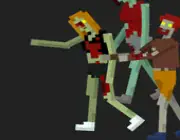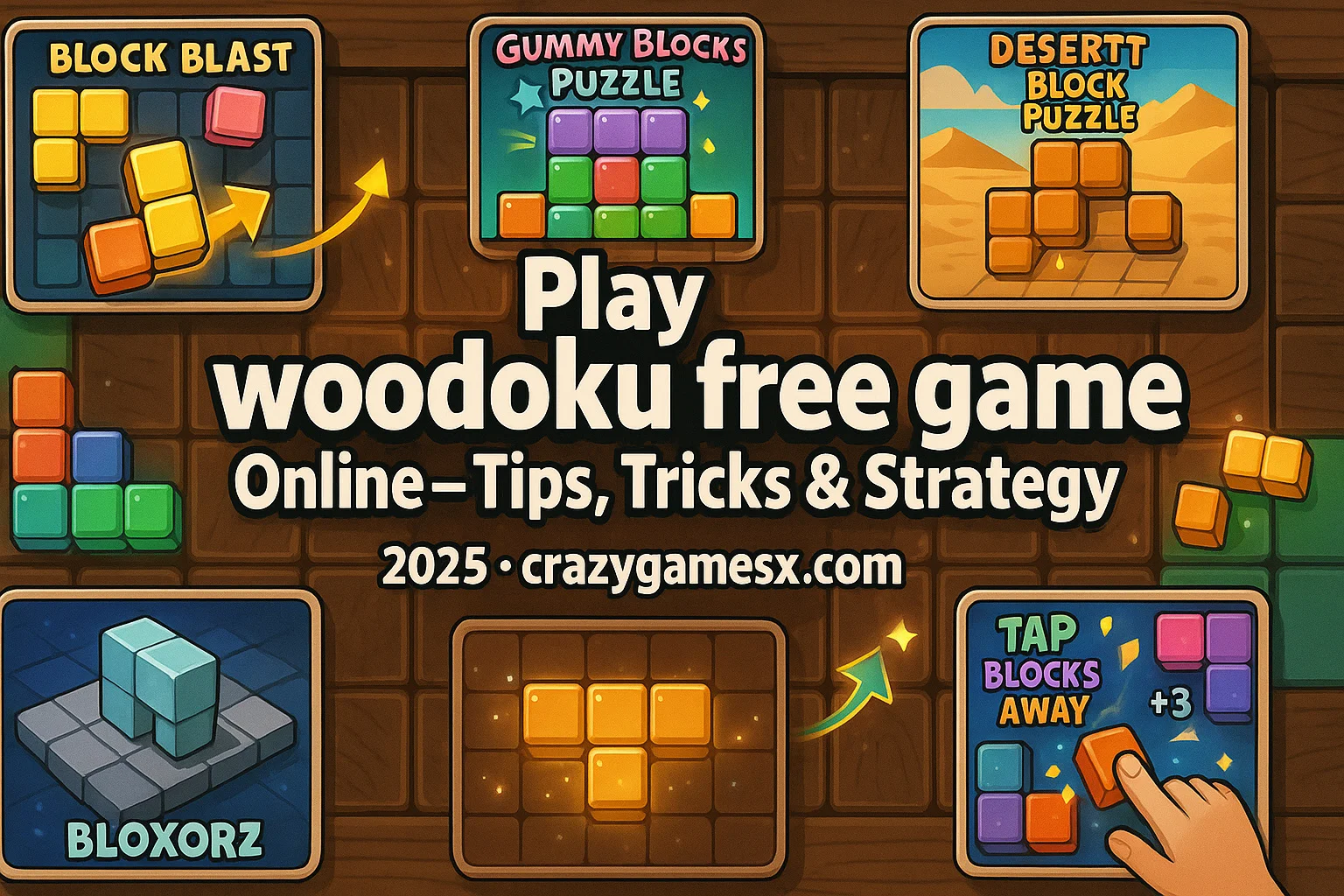Block-placing puzzles have been around since forever, but there’s a reason wood-style grid games are still topping “most played” charts: they’re easy to start, hard to master, and dangerously addictive. If your brain enjoys tidy rows, clean clears, and combo chains lighting up like a pinball machine, you’re in the right place. This guide is your straight-shooting, no-fluff playbook to crush scores in woodoku-style block puzzles on the web.
Want to jump in first and read later? Start woodoku free game instantly. Then come back for the sauce: how to place smarter, chain clears, and survive those late-game droughts without nuking your run.
What Is “woodoku free game”?
Think of “woodoku” as a simple blend: a 9×9 grid, a stream of polyomino shapes (the classic Tetris-like pieces), and rules that reward you for completing full rows, columns, or 3×3 boxes. There’s no falling gravity, no time pressure by default—just pure logic. Your job: place pieces so each move keeps options open for the next wave. The best players don’t just clear lines; they stage clears that trigger combos and streaks for bonus points.
At its heart, woodoku sits under the umbrella of the puzzle genre. If you want the formal definition, it’s part of the broad family of the puzzle video game—games that challenge pattern recognition, planning, and problem-solving without relying on twitch reflexes or RNG gimmicks. Pure signal. Minimal noise.
How to Play (and Actually Improve)
Let’s stop pretending you “just play for fun.” You want higher scores. Do this:
-
Master the grid basics
-
You clear a row, column, or 3×3 box by filling every cell in that line/region.
-
Clearing multiple at once gives combo points; clearing on consecutive moves creates streak multipliers.
-
-
Piece pack cadence
-
Pieces usually arrive in packs of three. You can place them in any order.
-
The pack refreshes only after you place all three, so every pack is a mini-puzzle with a “how do I spend these efficiently?” vibe.
-
-
Placement setup priorities
-
Start wide: build from the center out; avoid sealing corners too early.
-
Leave “ports”: keep at least one open “L corner,” one long lane (for 1×4, 1×5), and one near-complete 3×3 to cash in a box.
-
Reserve real estate for bulky shapes (3×3 squares, 5-long bars, fat L’s).
-
-
Objective loop
-
Place → create/maintain future placements → aim for multi-clears → protect your lanes → repeat.
-
Every move should either set up a clear or avoid a dead shape later.
-
-
Modes (typical variations)
-
Classic: infinite deck until you run out of space.
-
Timed/Daily: self-explanatory—play efficient.
-
Challenge sets: specific score or streak targets; learn pacing.
-
Smart Tips (Beginner → Advanced)
Beginner
-
Don’t panic-place. You’re not under a timer. Check all three pieces and imagine how they fit together before placing the first.
-
Prioritize flexibility. Early on, open up the middle. Avoid carving awkward cavities you can’t fill later.
-
Complete 3×3 boxes on purpose. Keep two cells open in a box so any 2-cell piece finishes it clean.
Intermediate
-
Stagger clears. Instead of clearing one row now and one next, align placements to pop row + column or row + 3×3 together.
-
Balance asymmetry. If the left side gets cramped, invest the next placement on the right to reset your board symmetry.
-
Shape memory. Learn the ugly customers—the 3×3 block, 5-bar, fat L. Mentally reserve parking spots for them.
Advanced
-
Combo architecture. Build near-complete regions that share cells. One perfect placement triggers double/triple clears.
-
Pack ordering. If your pack has a monster shape, place it first while you still have space. Keep small, flexible shapes for last-second rescues.
-
Sacrifice for streaks. Sometimes a slightly suboptimal placement today protects a streak multiplier that’s worth much more over the next three turns.
-
Dead-shape detection. Train your eye to spot patterns that can’t be completed (e.g., isolated single holes). If you create one, immediately plan how to dissolve it.
Why It’s So Addictive (No Cap)
-
Perfect-info high. No randomness you can’t see—only you and the grid. When you pop a triple clear you set up two turns ago, that’s skill, not luck.
-
Short loops, big dopamine. One pack = one micro puzzle. You get constant “I solved it” hits without a 40-minute grind.
-
Clean feedback. The wood clicks, the lines flash, the score climbs. Your brain knows what “good” looks like at a glance.
-
Infinite mastery ceiling. There’s always a tighter placement, a cleaner chain, a combo you missed. You never really “finish” getting better.
Similar Games You’ll Love
1) Block Blast
If you enjoy the wooden aesthetic and “complete rows/columns/boxes” logic, you’ll feel right at home with Block Blast. It respects your time: quick packs, responsive placement, and a scoring curve that rewards foresight instead of chaos. The vibe is bright and clean; you can read the board instantly, which matters a lot when you’re juggling two potential combos and a nasty 5-bar waiting in the pack. The best way to win here is to build multi-region tension—line up a near-complete row and a 3×3 box so a single L-piece detonates both. It’s ridiculously satisfying and the points spike is chef’s-kiss. If your early game keeps collapsing, try this: open with central placements, lay a “track” across the middle row or column, and protect space for a 3×3 block on one side. That template scales across runs and keeps you from trapping yourself in corners. When you’re ready to lock in a PB, Block Blast - Play Online Games Free is a strong pick.
2) Gummy Blocks Puzzle
This one dresses the grid in candy colors, but make no mistake—Gummy Blocks Puzzle is a logic workout. You’ll still chase the holy trinity of clears (row/column/3×3), but the star feature here is flow. Packs appear at a rhythm that encourages you to “stage, stage, cash-in,” and the sound/visual feedback makes it easy to track streaks. Pro tip: float your long bars along the edges first; then plant smaller shapes inside to finish lines without choking your lanes. Another strong habit is leaving two-cell hooks on both halves of the board so awkward S/Z pieces have a home. When your board gets cluttered, zoom out mentally: can a single square placement convert a two-line clear if you set it up now? Usually yes—if you don’t squander your 3×3 space early. Get your teeth into it here: Gummy Blocks Puzzle - Play Online Games Free - Crazy Games.
3) Desert Block Puzzle
Desert Block Puzzle swaps the wooden vibe for a sun-baked palette that keeps contrast high and distractions low. Under the hood, the scoring still favors combos and consecutive clears, so the skill ceiling matches woodoku-style play. What makes this title pop is how clean the silhouettes are—you can evaluate shape fit at a glance, which makes pack ordering decisions faster and safer. Strategy corner: build a “flex spine”—a continuous lane spanning the board that’s always ready for a 4- or 5-bar—then develop two 3×3 boxes on opposite sides. That layout shrinks dead-end probability and makes it trivial to trigger doubles. If you’re aiming at leaderboard-grade scores, you’ll want to avoid overfilling near corners until you have a guaranteed payoff. When you’re set to try it, roll out to Desert Block Puzzle - Play Online Games Free - Crazy Games.
4) Bloxorz
Okay, curveball time. Bloxorz isn’t a woodoku clone—it’s a spatial block-sliding puzzle that flexes the same brain muscles differently. You’re rolling a rectangular block around floating platforms, trying not to fall while landing perfectly on the goal tile. Why include it here? Because mastering woodoku means building strong spatial intuition, and Bloxorz is like weight training for that skill. You’ll learn to visualize orientation changes, anticipate constraints, and plan three moves ahead. All woodoku fundamentals. Don’t be fooled by its retro look; it’s a certified classic that punishes sloppy planning and rewards crisp mental modeling. If your scores plateau in grid puzzles, alternate sessions with this to sharpen your vision. Start the gauntlet: Bloxorz - Play Online Games Free.
5) Tap Blocks Away
Tap Blocks Away flips the script: instead of placing pieces to build lines, you’re removing blocks tactically to collapse the board and set up bigger clears. It’s the same dopamine loop from a different angle—predict how the board will settle, then tap with intent. This is fantastic cross-training for woodoku because it forces you to think about resulting shapes rather than just current placements. You’ll develop a better feel for “what the board will look like in two moves,” which translates back into smarter staging in 9×9 grid games. Use it as a palette cleanser between high-focus runs: short, punchy sessions that keep your pattern-spotting sharp without mental burnout. Plan your taps, then let gravity do the flex: Tap Blocks Away - Play Online Games Free.
Why Play Here (Real Talk)
You want fast loads, instant inputs, and zero sketchy downloads. That’s the vibe. The platform is built for quick sessions that don’t throttle your device, whether you’re on desktop at home or sneaking in a five-minute brain jog on mobile at lunch. Games launch in-browser, UI is clean, and everything plays nicely with touch or mouse. No registration pressure. No hoops. Just play.
Performance matters in puzzle games more than people admit. If your inputs hiccup or the board lags, your whole rhythm shatters. Here, latency is low, and the presentation is minimal but readable, which lets your brain stay locked on the grid. That means more smart decisions, fewer “oops, mis-clicked” moments, and—yes—higher scores.
Conclusion
If you love the neat click of pieces locking into place and the sweep of a triple clear, woodoku-style games will keep your brain fed for years. The ceiling is practically infinite because the puzzle is you vs. your own planning. There’s no meta build, no unlock grind, no loot box. Just cleaner choices, smarter setups, and that smug grin when a single L-piece detonates a row, a column, and a box on command.
So don’t overthink it. Warm up with a couple of stress-free packs, then start staging doubles and preserving lanes like a pro. Swap in a few rounds of Bloxorz or Tap Blocks Away to sharpen your spatial reads, then come back and demolish your PB. If your board looks messy, reset your symmetry and protect space for the 3×3 chunk. Do that consistently and your scores won’t just climb—they’ll spike.
If you’re still reading, your fingers are itching. Go get the grid.
FAQ
1) Is woodoku free game actually free to play?
Yep. You can play right in your browser without paying or downloading anything. Load it up, place blocks, chase combos—done.
2) What’s the fastest way to boost my score?
Stage multi-clears. Build near-complete rows/columns/3×3 boxes that share cells so one placement triggers two or three clears. Protect lanes for long bars and keep a home ready for the 3×3 block.
3) I keep running out of space. What am I doing wrong?
You’re probably sealing corners too early or overfilling the edges. Start central, leave ports for long bars, and maintain at least one half-open 3×3 area at all times. Also place the biggest piece in your pack first.
4) Are there any “bad” shapes I should plan around?
Not bad—just demanding. The 3×3 square, 5-long bar, and fat L cause most deaths. Always reserve flexible space that can accept them; don’t rely on perfect RNG to bail you out.
5) How do streaks and combos work?
A combo happens when one placement clears multiple lines/regions at once. A streak is clearing on consecutive moves. Both stack into huge score spikes. Plan placements that keep the clearing chain alive for 3–5 turns in a row for max profit.










































